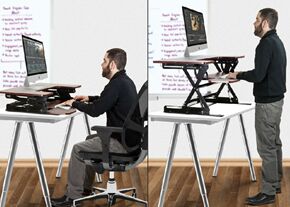坐立两用桌是否真的那么神奇?
|
They're good for some things, but researchers say they're not the magic bullet solution for health that many would like them to be. Remember when everyone was talking about standing desks? They were hailed as a calorie burner, a cure for obesity, an instant energizer. Now that many office workers have had a few years to use them, there is more evidence available as to whether they're really so fantastic – or not.
Researchers from Tufts University's Office Ergonomics Committee conducted a review of 53 studies that have been done on sit-stand desks – specifically, those that are designed to change heights. They analyzed the desks' effects on six categories: behavior (e.g. time spent sitting and standing), physiological, work performance, psychological, discomfort, and posture. What they found is that sit-stand desks are most effective at relieving physical discomfort. study co-author April Chambers, a bioengineering professor at the University of Pittsburgh, told cnn, "We saw consistently across the studies an improvement in discomfort and pain as people use the desks. And this was found not only in people who, for example, experienced low back pain, but also in adults with obesity and in healthy populations as well." Sit-stand desks performed ambiguously when it came to boosting attentiveness and productivity. Chambers said, "They don't make you more alert, but they don't make you less alert", and they don't have "any negative effects on work performance." In terms of physical health, no improvements to blood pressure were detected, nor weight loss through standing. Where sit-stand desks excel is in encouraging a user to move, because that's what the human body really needs. Whether it's shifting from foot to foot while standing or changing between sit-stand positions throughout the day, it's important to avoid being still and sedentary for prolonged periods of time. The researchers offer the following advice for using sit-stand desks most effectively: 1. Change positions frequently. Make a point of switching between sitting and standing every half hour. 2. Use good posture. Stand with legs under hips or sit with knees at a 90-degree angle for optimal posture. 3. Use an anti-fatigue mat under your feet. This can reduce lower back and leg pain. 4. Stand after eating lunch. It encourages you to move a bit more, which will help with digestion and burning calories. 5. Incorporate walking into your day. Take a break from the desk altogether during phone calls or meetings, if you can. |









